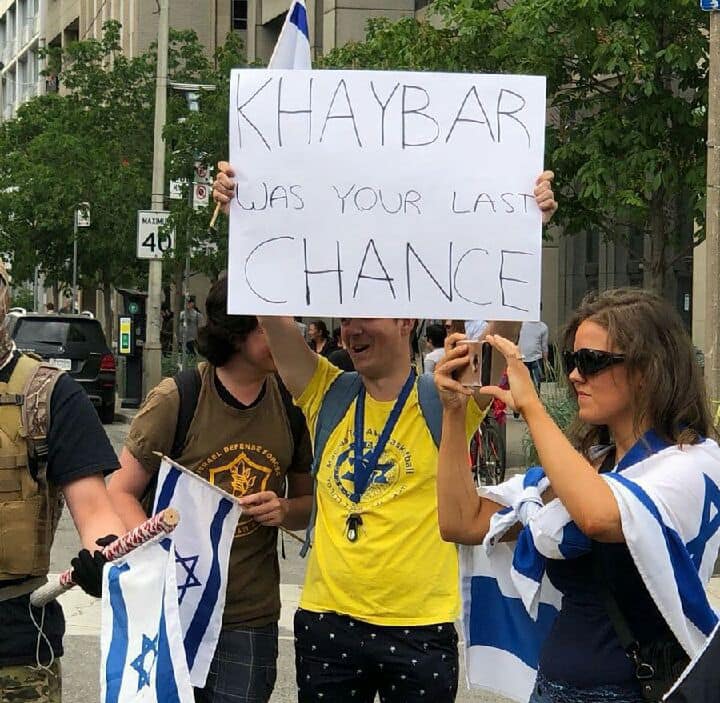June 4, 2019
The pro-Israel lobby is apoplectic.
After pulling out all the stops to end the annual Al Quds Day rally in Toronto, the lobby failed spectacularly to stop it.
Now, in an effort to heighten pressure on Toronto City staff and police to violate the constitutional rights of Palestinian solidarity protesters, the lobby has launched a new and desperate smear campaign.
According to a report issued by B’nai Brith Canada on June 2, 2019 (the day after this year’s rally), the sign pictured above was carried by a protester at the rally.
According to B’nai Brith:
The sign depicts the Dome of the Rock in Jerusalem and warns that, “The last Khayber is ready,” an allusion to an ancient battle in which a Muslim army defeated and slaughtered Jews in the Arabian Peninsula. It also predicts the coming of “the last Hayder,” a nickname for Ali, the leading figure in Shi’a Islam.
Before I address B’nai Brith’s interpretation of the sign, a few preliminary observations are in order.
First, the organizers of the rally (for whom I act as legal counsel) commissioned a set of placards for use at this year’s rally. The content of those placards was carefully reviewed and considered. The sign shown in B’nai Brith’s report of June 2, 2019 was never approved by organizers. They had nothing to do with it.
Second, at the Al Quds Day rally held in Toronto last year, a pro-Israel counter-protester was photographed carrying a poster which referenced Khaybar:

That counter-protester’s provocative poster from last year may well have elicited a reaction from the protester who carried the “Khayber” sign at this year’s rally.
Third, the photograph published by B’nai Brith shows only one sign referencing “Khayber.” By my estimation, over 1,000 protesters participated in this year’s rally. Moreover, the rally was held in an open public space across from the United States Consulate on University Avenue. In such circumstances, it is extremely difficult if not impossible to prevent someone from sneaking into the throng with an objectionable sign.
In essence, B’nai Brith’s insinuation is that all participants and organizers of this year’s rally are guilty by association with someone who, acting on his own initiative and without the organizers’ consent or foreknowledge, elected to use a sign bearing the word “Khayber”.
That, of course, is ludicrous.
B’nai Brith’s interpretation of the sign is even more suspect than its employment – yet again – of the tactic of guilt by association.
First, the “Khayber” sign featured in the B’nai Brith report makes no reference to the Jewish people, nor does it contain any reference to a “battle” or to any other form of violence. The sign contains no violent imagery at all.
On the contrary, the sign prominently features the image of a dove carrying an olive branch, one of the most ancient symbols of peace. Predictably, B’nai Brith’s June 2 report fails even to acknowledge that the sign bears this widely-recognized symbol of peace.
Second, the slogan printed on the sign is difficult to comprehend: “LAST KHAYBER IS READY… SO AS LAST HAYDAR AS.”
How can anyone say with confidence what that language was intended to convey?
Today, Khaybar is an oasis in Saudi Arabia lying to the north of the Medina. In the seventh century, it was the site of a battle between Muslims and Jews.
According to B’nai Brith, Khaybar was the site of a “historical massacre of Jews” and “an ancient battle in which a Muslim army defeated and slaughtered Jews in the Arabian Peninsula.”
That, however, is a highly misleading description of the battle of Khaybar. B’nai Brith’s simplistic characterization of the battle as a “historical massacre of Jews” suggests a wholesale slaughter of defenceless Jewish civilians – the type of anti-Semitic atrocity that occurred, over and over again, during the Nazi genocide.
As Wikipedia‘s detailed account makes clear, that is not at all what happened during the battle of Khaybar. First, from the perspective of the Muslim forces, the attack on Khaybar was defensive in nature, inasmuch as it was provoked by “machinations” against Muhammad by the Banu Nadir, a Jewish tribe that lived at that time at the oasis of Medina. According to Scottish historian Montgomery Watt, the Banu Nadir’s ‘incitement’ against Muhammad “left him no choice but to attack.” Second, the Jewish forces at Khaybar vastly out-numbered Muslim forces – by a ratio exceeding 5:1. Third, although there was certainly bloodshed on both sides, the battle concluded with Muhammad agreeing to treat the inhabitants of the last two unconquered fortresses leniently.
(Below I have pasted the pertinent extracts from Wikipedia‘s account of the battle.)
At the end of the day, we do not know why some random protester entered the Al Quds Day rally with a sign which included both the word “Khayber” and the image of a dove carrying an olive branch.
We can say two things with complete confidence, however. First, that sign was isolated and had nothing to do with the organizers. Second, the battle of Khaybar was not a mass slaughter of defenceless Jewish civilians.
These are vital facts which B’nai Brith has chosen to misrepresent and ignore for one simple reason: B’nai Brith and the other pro-Israel lobby groups and politicians who have repeatedly smeared the Al Quds Day organizers cannot endure that, every year, in the heart of Canada’s largest city, a multitude of conscientious Canadians demand justice for Palestinians and accountability for the Israeli war criminals who oppress them.
**********
[EXCERPTS FROM WIKIPEDIA‘S ACCOUNT OF THE BATTLE OF KHAYBAR]
In the 7th century, Khaybar was inhabited by Jews. The inhabitants had stored in a redoubt at Khaybar a siege-engine, swords, lances, shields and other weaponry…
The oasis was divided into three regions: al-Natat, al-Shikk, and al-Katiba, probably separated by natural divisions, such as the desert, lava drifts, and swamps. Each of these regions contained several fortresses or redoubts including homes, storehouses and stables. Each fortress was occupied by a separate family and surrounded by cultivated fields and palm-groves…
After they were sent into exile in 625 from Medina by Muslim forces, the Banu Nadir [a Jewish tribe] had settled in Khaybar. In 627, the Nadir chief Huyayy ibn Akhtab together with his son joined the Meccans and Bedouins besieging Medina during the Battle of the Trench. In addition, the Nadir paid Arabian tribes to go to war against the Muslims. Bribing Banu Ghatafan with half of their harvest, Banu Nadir secured 2,000 men and 300 horsemen from the tribe to attack Muhammad, and similarly persuaded the Bani Asad. They attempted to get the Banu Sulaym to attack the Muslims, but the tribe gave them only 700 men, since some of its leaders were sympathetic towards Islam. The Bani Amir refused to join them all together, as they had a pact with Muhammad. Once the battle started, Huyayy ibn Akhtab persuaded the Banu Qurayza to go against their covenant with Muhammad and turn against him during the battle. After the defeat of the confederates in the battle, and Qurayza’s subsequent surrender, Huyayy (who was at that time in the Qurayza strongholds of Medina) was killed alongside the men of the Qurayza. After Huyayy’s death, Abu al-Rafi ibn Abi al-Huqayq took charge of the Banu Nadir at Khaybar. Al-Huqayq soon approached neighboring tribes to raise an army against Muhammad. After learning this, the Muslims, aided by an Arab with a Jewish dialect, assassinated him.
Al-Huqayq was succeeded by Usayr ibn Zarim. It has been recorded by one source that Usayr also approached the Ghatafan and rumors spread that he intended to attack the “capital of Muhammad”. The latter sent Abdullah bin Rawaha with a number of his companions, among whom were Abdullah bin Unays, an ally of Banu Salima, a clan hostile to the Jews. When they came to Usayr, they told him that if he would come to Muhammad, Muhammad would give him an appointment and honour him. They kept on at him until he went with them with a number of Jews. Abdullah bin Unays mounted him on his beast until he was in al-Qarqara, about six miles from Khaybar. Usayr suddenly changed his mind about going with them. Abdullah perceived Usayr’s bad intention as the latter was preparing to draw his sword. So Abdullah rushed at him and struck him with his sword cutting off his leg. Usayr hit Abdullah with a stick of shauhat wood which he had in his hand and wounded his head. All Muhammad’s emissaries fell upon the thirty Jewish companions and killed them except one man who escaped on his feet. Abdullah bin Unays is the assassin who volunteered and got permission to kill Banu Nadir’s Sallam ibn Abu al-Huqayq at a previous night mission in Khaybar.
Many scholars have considered the above machinations of the Nadir as a reason for the battle. According to Montgomery Watt, their intriguing and use of their wealth to incite tribes against Muhammad left him no choice but to attack. Vaglieri concurs that one reason for attack was that the Jews of Khaybar were responsible for the Confederates that attacked Muslims during the Battle of the Trench. Shibli Numani also sees Khaybar’s actions during the Battle of the Trench, and draws particular attention to Banu Nadir’s leader Huyayy ibn Akhtab, who had gone to the Banu Qurayza during the battle to instigate them to attack Muhammad.
[…]
The Muslims set out for Khaybar in May 628, Muharram 7 AH. According to different sources, the strength of Muslims army varied from 1,400 to 1,800 men and between 100 and 200 horses. Some Muslim women (including Umm Salama) also joined the army, in order to take care of the wounded. Compared to the Khaybarian fighting strength of 10,000, the Muslim contingent was small, but this gave Muslims advantages. It allowed Muslims to swiftly and quietly march to Khaybar (in only three days), catching the city by surprise. It also made Khaybar overconfident in themselves. As a result, the Jews failed to mount a centrally organized defense, leaving each family to defend its own fortified redoubt. This underestimation of the Muslims allowed Muhammad to conquer each fortress one by one with relative ease, claiming food, weapons, and land as he went. One Muslim reported:”We met the workers of Khaybar coming out in the morning with their spades and baskets. When they saw the apostle and the army they cried, ‘Muhammad with his force,’ and turned tail and fled. The apostle said, ‘Allah Akbar! Khaybar is destroyed. When we arrive in a people’s square it is a bad morning for those who have been warned.'”
The Jews, after a rather bloody skirmish in front of one of the fortresses, avoided combat in the open country. Most of the fighting consisted of shooting arrows at a great distance. On at least one occasion the Muslims were able to storm the fortresses. The besieged Jews managed to organize, under the cover of darkness, the transfer of people and treasures from one fortress to another as needed to make their resistance more effective.
[…]
After the forts at an-Natat and those at ash-Shiqq were captured, there remained the last and the heavily guarded fortress called al-Qamus, the siege of which lasted between thirteen and nineteen days.
[…]
The Jews speedily met with Muhammad to discuss the terms of surrender. The people of al-Waṭī and al-Sulālim surrendered to the Muslims on the condition that they be “treated leniently” and the Muslims refrain from shedding their blood. Muhammad agreed to these conditions and did not take any of the property of these two forts.
[Emphasis added; footnotes omitted.]





